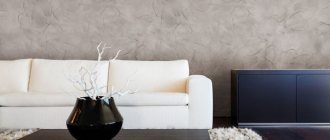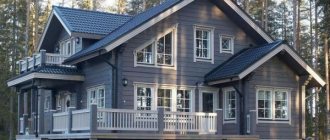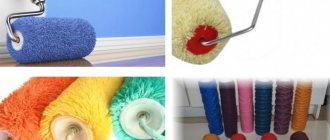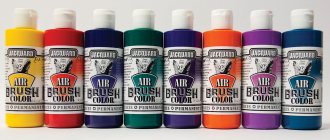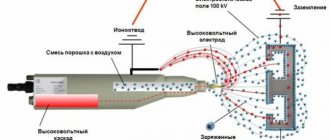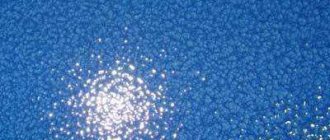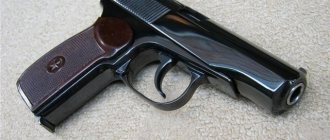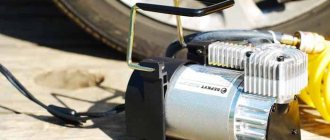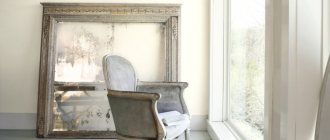When working with paint and varnish products, it is necessary to protect the respiratory system from harmful, toxic fumes. It is important to use a paint respirator when painting, it will provide protection from exposure to toxic fumes and should be used by both beginners and professionals in the painting industry. This article will discuss the main types of respirators, their functions, selection rules and the negative consequences of neglecting the use of a mask.
Purpose of the respirator
This mask protects a person’s face and is used during various jobs that involve the use of chemicals, such as paint. Toxic vapors, along with the air, enter the human respiratory organs, from where they penetrate the circulatory system and can lead to mild and severe poisoning. When applying paint, paint masks are used. Special protective masks are worn by:
- during dyeing, to protect the respiratory system;
- when working with chemical, toxic fumes;
- during work with spraying;
- during renovation and construction work, when there is too much dust in the room;
- in the production of paints and varnishes.
To use restaurateur, you need to analyze the following conditions:
- frequency and frequency of work;
- type of harmful chemical products;
- the conditions under which the work is performed;
- indicator of pollutant concentration.
Advantages
When choosing protective equipment, you need to pay attention to their main advantages:
- light weight, so the body will not be loaded;
- low resistance during the breathing process;
- a sufficiently long period of time during which you can use masks.
If you have to work with paints that contain a lot of toxins, it will be difficult for a respirator to protect your respiratory organs from odors, since toxins are absorbed even through the skin. In such cases, a full protective suit is needed.
A protective painting suit will protect your skin and prevent toxins from being absorbed into your body.
How to choose the right protective mask
Only an experienced, qualified specialist painter can give the correct answer to the question of which respirator or face mask is best to use in a given situation. If a person has never performed repair, construction or painting work, it will be difficult for him to choose a suitable respirator. The following information will help you choose the right respiratory protection mask. Several types of respiratory models are produced today:
- half masks;
- masks that completely cover the entire face;
- protective masks with air supply;
- full face masks complete with breathing equipment that maintains constant air pressure.
Respiratory protection masks are available in reusable and disposable versions. It is desirable that a respirator for painting have replaceable valves and filters, and that the protective material is of high quality and does not cause allergic reactions. A person should not feel discomfort while using a face mask.
All masks can be divided into two types of respirators, which differ from a technical point of view. They protect the respiratory tract from odors, dust particles, coarse dust and chemicals:
- Filtering respirators. They are equipped with special filters through which the inhaled air passes. Structurally, these masks resemble gas masks.
- Insulating. This type of respirator includes a special container for an oxygen mixture supplied through a hose to the respiratory organs.
One of the most important characteristics of an anti-aerosol and anti-dust respiratory device is the protection class. All protective masks are divided into 3 classes:
- FFP1. This includes class 1 filtering half masks. They retain more than 80% of harmful substances in the air;
- FFP2. This class includes filtering half masks that filter more than 94% of harmful impurities;
- FFP3. A filter half mask of this type retains 99-100% of harmful substances.
Life-saving personal respiratory protection equipment
Emergency equipment protects the user during evacuation from a hazardous area - therefore the equipment must have different parameters and parameters than standard protective measures. It is important to note that rescue equipment should not be used for everyday work.
The correct selection of respiratory protection half masks is essential for the protection of the wearer and requires the utmost care. To choose the right half mask and properly protect your respiratory tract, follow these guidelines:
- The type, nature and concentration of hazardous substances must be specified or known. Measurements can be carried out, for example, by professional associations. Working conditions must also be known, taking into account occupational exposure limits.
- The environment must contain sufficient oxygen. Please note that according to German legal requirements, this corresponds to a minimum of 17% by volume.
- If other personal protective equipment is necessary, it must be adapted to other conditions. The protective half masks sold in our online store in Moscow are ideal for combination with safety glasses.
Personal respiratory protection is not suitable for people with a beard, sideburns or deep scars near the sealing contours of the mask.
Half masks marked “NR” can be used for up to 8 hours. Half masks marked with an “R” can be used for up to 24 hours, but should be cleaned after each use. As such, the half mask should always be replaced if there is a noticeable increase in breathing resistance.
To improve wearing comfort, some half masks are only available with an exhalation valve. If a gas mask is required in the workplace, half masks do not provide sufficient protection.
Types of respirators
They produce many different types of painting respirators, as well as various painting masks. To ensure safe application of paints and varnishes, you need to choose a respiratory model that can protect against fumes of those chemicals that boil at temperatures less than 60 degrees.
Which mask is better to choose? There are several excellent options, for example, PPM-88 and RU-60M are very popular; they are used mainly for protection against paint fumes. These models are not suitable for use in a paint shop, in complex technological production, or during manipulation with various building mixtures.
A 3M respirator is excellent for repair, construction and finishing work. This device protects not only from paint fumes, but also from dust, gas and particles of various substances. 3M products are of high quality and are reliable devices that effectively protect breathing over a long period of time. These respirators for painting and other work meet all modern safety requirements; they fit quite tightly to the skin of the face, so during inhalation, dust particles and paint vapors do not penetrate the respiratory system, and therefore do not cause harm to human health. The cost of 3M respirators is relatively low, affordable for everyone.
If you have to apply paint that contains many toxic substances, then the paint mask will not effectively protect the respiratory tract. And if a person has to work in a room in which the dust concentration is several times higher, then a regular protective mask will not give the necessary protective result. In such situations, a special protective suit is suitable for applying paint or other finishing materials.
Special personal protective equipment is produced for applying paint to cars. Such a paint mask provides reliable protection against harmful, toxic substances, for example, xylene, toluene, benzene, and various carbon disulfide compounds. To paint the body or parts of a car, you need to purchase a special filtering respirator for paint fumes.
It is unacceptable to apply paint to a car indoors without a respirator or use a paper mask. Some workshops use simple foam rubber bandages for workers, which are secured with ordinary ties; it is very harmful to breathe toxic paint fumes through such devices.
How to protect yourself from dust getting into your body while working
For more reliable protection, it is necessary to take into account some nuances. Let's consider the main points and rules that must be followed during construction work. These recommendations are useful for preventing dust from entering the human body:
- When working outdoors, never work against the wind. If the wind is strong, be sure to turn your back to it. However, if this is not possible, it is necessary to tightly “attach” the respirator and other PPE (personal protective equipment);
- a tight fit is a very important nuance when protecting the respiratory tract from dust. If the work is very toxic or dusty, you should wear a respirator in front of a mirror. This way you can check whether there are gaps between the skin and the mask;
- The most important thing is to never start dusty work without a mask. Small particles of building materials have a bad effect on the human body. Even if you don’t have a respirator at hand, and the work needs to be done urgently, you can make your own mask from available materials (it is important to choose thick fabric).
Video - About dust in a nutshell
Types of filters
Filtering respirators operate by creating and temporarily holding a cushion of air. For example, a 3M respirator has a filter installed that traps air, while harmful particles settle on the protective material; the respirator works on the principle of absorption. When the air is purified, it is directed into the lungs; this principle is very important during repair and finishing work and when applying paint. Coal or cotton wool folded in several layers is used as a protective filter material.
They produce respirators not only against paint fumes, but also have dust filters that provide protection from the smallest dust particles. Anti-aerosol filters are also made; they protect against small aerosol particles that are formed during paint spraying.
Vapor and gas respirators protect against fumes that either have an odor or may be odorless. These substances are very dangerous as they can cause serious harm to human health. Gas masks are divided into 2 groups:
- combined. This type is very popular; respirators of this group effectively cope with various influences at the same time, however, these masks are quite expensive;
- insulating. They are more effective than filter models because they do not allow chemicals to come into contact with the skin of the face. Thanks to this, a person will not be poisoned by finely dispersed particles and will not experience an allergic reaction.
Communities › All about Paint and Painting › Blog › Almost eternal respirator
At the request of a fellow colleague, I’m sharing a modified mask (which he saw on me), maybe someone else will need it. Let me make a reservation right away: the idea is not mine. I saw it here on D2. (www.drive2.ru/c/1807519/) I just thought it up and modified it for myself
Comments 41
the idea is very good, but it wouldn’t hurt to buy a membrane compressor for this mask, then you will definitely have clean air. The carbon filter also does not block 100%
It’s better to filter relatively clean compressor air than onion fog, but for good reason you need to change your profession☺
For this purpose, the air passes through carbon filters in the mask, and not direct input is made.
Thank you for the article! I'll make it for myself.
To be able to use air for human breathing, the compressor must contain special oil! Or the compressor must be a membrane one!
My mask gets air through carbon filters and not directly.
Probably the same for sandblasting! I should probably think about it. Thanks for the idea!
1 I don’t understand. It ends at the most inopportune moment. There is no control over the efficiency of the filter. 2, this is how they pass through carbon filters. The oil does not burn because the head is warm and water-cooled. 3 You need to take care of your health while you have it. And don’t breathe in any dust or fumes.
The carbon filters remain in the mask. I breathe through them. The compressor is located separately in the basement.
One fig from filters has not completely gone away, which means
There was no such goal, I left the filter to calm myself down. With positive pressure it’s easier to breathe.
somehow I didn’t notice. It’s cool, yes. You set the comfort mode with the dial and go. And I don’t paint for more than half an hour. I take a technological break for the interlayer. If the air pressure is not strong, my face sweats. I make a little breeze
Oh, and also make an air flow temperature regulator in the face and put an air ionizer in place, so it’s possible to outdo SATA!))))) Cool idea, definitely bookmark it!
What kind of compressor? Are you going crazy?
You won’t believe it. Homemade ZIL modified and 350 liter receivers
I didn’t apply for a patent))) I don’t paint that often, and such a suit certainly wouldn’t have paid for itself. but I have an exclusive lift.)
It’s better when you made it yourself, with your own hands! But even a fool can buy it. I just saw it - hello fellow countryman :-)
If a fool has a lot of money.
I stole the idea myself. But it’s worth doing
I really liked it! Beautiful!
This way you can pump 10 atmospheres of air into the balloon, 5 liters should be enough for a long time, and you won’t have to walk around tied up like Polkan))) There will only be a hump)))
Source
Toxic Hazards
It is important to know that many chemical compounds and paint vapors entering the human body through the respiratory system lead to a state of hypoxia. The first thing that affects the central nervous system is the following symptoms:
- coordination of movements is impaired, it is difficult to navigate in space;
- there is a fear of bright and dim light;
- loss of smell and taste;
- various hallucinations appear;
- panic attacks occur.
Poisoning with toxic substances causes the following somatic reactions:
- dizziness;
- nose bleed;
- joint pain;
- vomiting that is not associated with spoiled food;
- tachycardia (rapid heartbeat).
To prevent the above symptoms from occurring, it is important to use a suitable respirator when applying paint or when working with chemicals. If one of the listed symptoms occurs, you should immediately go outside and seek medical help. In some cases, chronic poisoning occurs due to the fact that a person systematically works with harmful chemical products without using a respirator or does not use it correctly.
History of appearance
The first effective means of protection against dust appeared thanks to Leonardo da Vinci and Alexander Humboldt (16-18 centuries). Respirators were made of cloth soaked in liquid or a bag that covered the head and had holes for the eyes.
Moistened cotton and wool served as additional filtering agents. Purification of harmful gases was carried out with lime and activated carbon. Chemist John Stenhouse (Scotland) invented the first respirator with an activated carbon filter. The fire respirator, developed by John Tyndall (England, 1871) consisted of two layers: coal, wool (impregnated with calcium hydroxide, glycerin).

